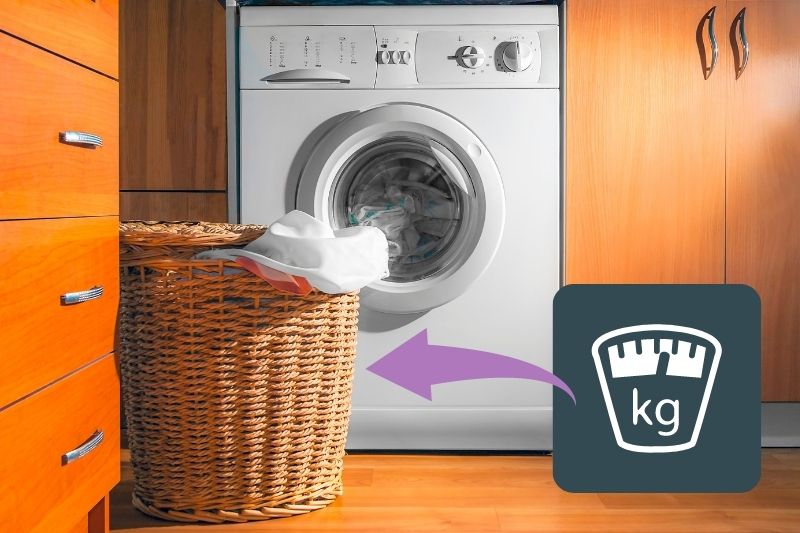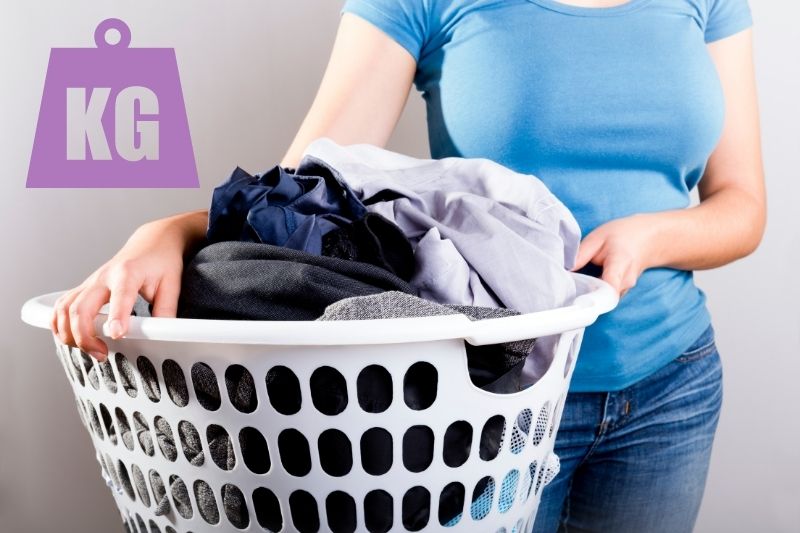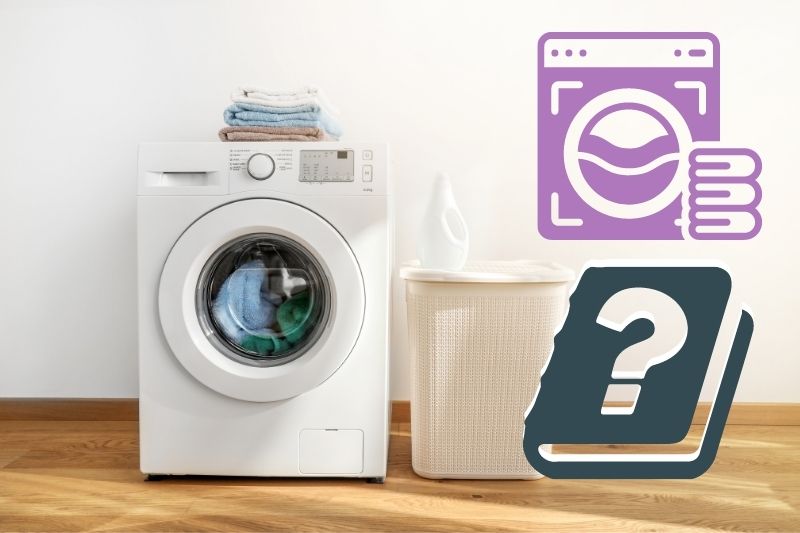It’s really easy to overlook your washing machine’s capacity guide when you’re in a rush.
But is ignoring your washing machine’s capacity guide something you should really be doing?
It’s actually really important to understand and to stick to the capacity guides noted on your washing machines. Why? Keep on reading and I’ll explain more!
What Does Washing Machine Capacity Mean?
A washing machine’s ‘capacity’ refers to how much laundry you can put in the machine at once. This measurement is usually in kilograms and will vary from one washing machine to another.
But, why is it important?
It’s crucial that you consider a washing machine’s capacity because it will affect the amount of washing you can do at once, and adding too much or too little laundry in can damage the machine and your clothes.
Plus, before you buy a washing machine, you need to make sure that you’re purchasing a washing machine that suits your home.
For example, if you have a big family, you’ll likely need a washing machine that can take larger loads of washing. Using a small washing machine might be less effective and more expensive, because you’ll have to wash smaller loads of laundry more often.
If you’re a single person on the other hand, you might not need a washing machine with a large capacity. So, you’d be better off buying a washing machine with a smaller capacity, around 5-6 kg, that could also save you money in the long term.
Additionally, larger capacity washing machines of about 10 kg and up are usually bigger in size. You’d need to make sure that you had enough room to store the washing machine in the first place.
Common Washing Machine Capacities Explained

If you’re looking at getting your first washing machine, or perhaps you’re upgrading to a newer washing machine, you may be a little overwhelmed by all the facts and figures you see online.
This can make choosing the right machine quite difficult, and after all you want to make the right choice, because washing machines come with hefty price tags in some cases.
So, here’s a guide to help you understand washing machine capacity guides better:
NOTE: The equivalent measurements given below are based on the author’s clothes and should only be used as guides. You will need to amend the figures according to your own items. In the examples below the following measurements apply:
Two pairs of thick jeans that weigh 0.5 kg each are the equivalent to 1 kg.
Two jumpers that weigh 0.5 kg each are the equivalent to 1 kg.
Washing machine’s come in the following capacities.
5 kg
This type of capacity would be suitable for a single person, or a couple/two people cohabiting.
This is the ideal sort of washing machine for someone who doesn’t wash clothes more than a couple of times a week. It’s also a good size machine for people who leave doing their laundry to the last minute and need things washed fast.
How much laundry could you put in?
On average, you could pop ten pairs of women’s jeans in to wash at once (jeans weigh 0.5 kg per pair). Or, you could wash five pairs of jeans and five jumpers at once (jumpers weigh 0.5 kg each).
6 kg
This type of capacity would be suitable for a couple or two people cohabiting together.
This is the ideal washing machine for two people who don’t need to do their laundry more than four times a week. This is also a good option for individuals who need their dirty washing cleaned quickly, because smaller machines can wash clothes a little faster.
How much laundry could you put in?
On average, you could wash 12 pairs of jeans at once (jeans weigh 0.5 kg per pair). Or, you could wash six pairs of jeans and six jumpers at once.

7 kg
A 7 kg washing machine would be suitable for a small family and it’s a popular size to buy.
This is ideal for a small family who are likely to be doing about 4-6 loads of washing per week.
How much laundry could you put in?
On average, you could wash 14 pairs of jeans at once (jeans weigh 0.5 kg per pair). Or, you could wash ten pairs of jeans (jeans weigh 0.5 kg per pair) and four jumpers (jumpers weigh 0.5 kg each) at once.
8 kg
This type of capacity would be suitable for a small-medium sized family, it is also a popular size.
This capacity is ideal for busier families that are likely to be washing clothes frequently during the week. You can also use this size to wash larger items in the home, like bedding.
How much laundry could you put in?
On average, you could wash 16 pairs of jeans at once (jeans weigh 0.5 kg per pair). Or, you could wash eight pairs of jeans and eight jumpers at once (jumpers weigh 0.5 kg each).
9 kg
This type of capacity would be suitable for a medium-large sized family.
This load size is ideal for homes that are going to be doing big loads of washing at once.
How much laundry could you put in?
On average, you could wash 18 pairs of jeans at once (jeans weigh 0.5 kg per pair). Or, you could wash nine pairs of jeans and nine jumpers at once (jumpers weigh 0.5 kg each).
10 kg
This type of capacity would be suitable for a large family.
This is one of the largest load sizes available to buy. It would be perfect for busy homes that need a lot of washing done regularly. It also means that you can do much larger washes, so maybe you won’t have to wash clothes as often during the week.
How much laundry could you put in?
On average, you could wash 20 pairs of jeans at once (jeans weigh 0.5 kg per pair). Or, you could wash ten pairs of jeans and ten jumpers at once (jumpers weigh 0.5 kg each).
11-12 kg
This type of capacity is typically the biggest one that is available to buy in stores and would suit a very large family.
This is ideal for extra busy homes and even some small hotels! The 11-12 kg washing capacity allows for much bigger, and often heavier, items to be washed. Things like bedding can be washed in washing machines of this size with ease.
How much laundry could you put in?
On average, you could wash 22-24 pairs of jeans at once (jeans weigh 0.5 kg per pair). Or you could wash 12 pairs of jeans and 12 jumpers at once (jumpers weigh 0.5 kg each).
Of course, the figures above are not exact because what washing machine you actually buy depends on your household circumstances, what you want to wash, and how much your clothes weigh.
The factors above will vary from one house to another, but all should be considered before you buy a washing machine.
For example, if you plan on washing bedding or curtains frequently, but you’re a couple, then you’d need to buy a 7 kg washing machine, at least, instead of a 5-6 kg one. Bedding and the likes get heavy very quickly, so the extra capacity will aid in the washing process.
How Can You Know How Much Your Dirty Laundry Weighs?
If you know how much the drum in your washing machine can hold, the next big question is how do you know how heavy your laundry is? After all, sitting down and measuring out exact piles of washing every single time is time consuming!
So, here are a couple of techniques to help you weigh out your washing:
- Stand on a weighing scale yourself and note down your weight. Then grab a pile of dirty laundry and weigh yourself again. Subtract your original weight from the larger number, and the weight left behind is what your pile of clothes measures. You can then add/remove clothes as you need to.
- Pop a couple of items onto a scale (one item at a time) until you reach the desired weight.
- Weigh out items that you wash regularly, so you have a rough idea of what your loads should feel like.

Once you’ve completed the above methods a few times you’ll be able to estimate how much your laundry weighs in no time at all.
Keep in mind that heavy items, like blankets and quilts, will get very heavy when they’re being washed in the washing machine. So, you will need to check your user handbook before assuming that you can wash such items in your machine.
Also, there may be a special setting you need to pick when doing such a wash, again check your handbook for further guidance.
How Do You Know if the Washing Machine Is Filled Up Correctly?
If you have followed the advice above then you should have popped roughly the right amount of laundry into the washing machine.
However, if you’re still not sure you can do the following test:
Pop your hand inside the washing machine when the laundry is inside. Push your hand to the top of the pile of laundry, you should feel a sufficient gap between the clothes and the top of the drum.
If there is a gap present then all is well. If you don’t feel a gap, you need to remove some dirty laundry.
Does the Capacity Refer to Dry or Wet Clothes?
The capacity of your washing machine refers to the DRY weight of your clothes.
There is no need to panic about clothes getting wet and heavy when the machine has started its cycle, because manufacturers have considered this beforehand. Measures have been put in place to deal with a load of clothes getting wet and heavy during a wash cycle.
As long as you stick to the correct capacity limit there shouldn’t be any problems.

Why Should You Stick to the Capacity?
Not sticking to the capacity of a washing machine may lead to issues. Examples of these problems are:
- A washing machine that is filled well above its capacity will not wash clothes properly.
- Washing machines that are not filled up enough may become off balance, and may not clean items as well as they should do.
- Washing machines that are filled up too much, too often, can put strain on the drum, and this can break in time.
- Not filling up your washing machine with enough dirty laundry will result in you wasting money, water, products and energy.

Bethan has a passion for exploring, reading, cooking and gardening! When she’s not creating culinary delights for her family, she’s concocting potions to keep her house clean!






